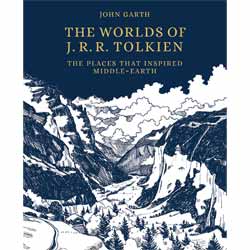|
Click here to return to the main site. Book Review
There is a certain amount of truth to the notion that all fiction is in some way biographical. Its inclusion may be as small as particular character traits borrowed from a friend to whole sections of life translated into a fictional world. The Worlds of J. R. R. Tolkien: The Places That Inspired Middle-Earth (2020. 208 pages) by John Garth is an extensive and fairly exhaustive examination of the internal and external influences which Tolkien brought to the creation of Middle-Earth. Presented as a hard-backed coffee table book (26.7 x 2.8 x 21.8 cm) Garth attempts to dispel much of the erroneous information around this subject. The style is semi- academic, which is a reflection on how serious he has taken his subject without being academically impenetrable. Although it is coffee table size it is designed to be read in order and works best this way, but with over one hundred illustrations, some from Tolkien himself, there is much to enjoy if you just want to browse random pages. The book opens with an introduction in which Garth puts forward the idea that whilst some of what is to follow springs from his own theories, he is still leaving it up to the reader to weigh the evidence. The bulk of the book, its eleven chapters, takes on a particular aspect of Tolkien’s worlds and then explores their likely genesis. The first chapter, 'England to the Shire' examines Tolkien’s experiences of England, a theme further developed in the book when Garth examines Tolkien’s dislike of the urbanisation and destruction of much of the shire towns and villages with the coming of road traffic, which helped to swallow up these little havens of beauty, much in the same manner as Saruman blighted the shire with industrialisation. Subsequent chapters examine the cultural influence on the world which he created and the link between the English and the Elves. There are then four chapters devoted to topological matters, which are mirrors to Middle-Earth and which buildings are likely candidates for architectural inspiration. The last chapters deal with some more direct influences. Tolkien was a philologist and constructed languages from an early age, his subsequent studies of German and Nose mythologies were fed, sometimes, directly into the creation of Middle-Earth. Overall, I found the book to have some really convincing arguments. Garth states that the inspiration for the book arose from seeing so many theories which were either poorly constructed or just plain wrong. While there is still room for debate about some of his ideas, this is probably the most authoritative book you are likely to find. 9 Charles Packer Buy this item online
|
|---|

